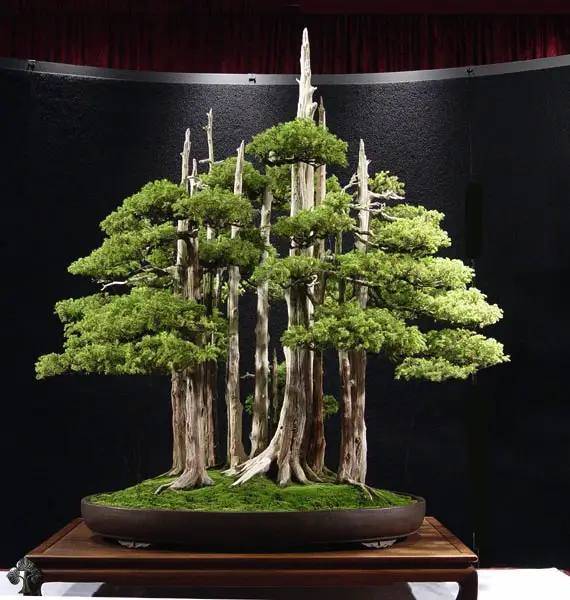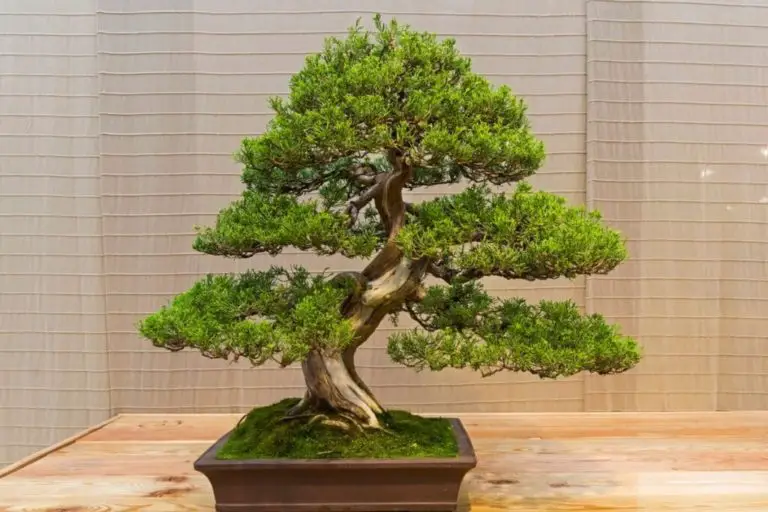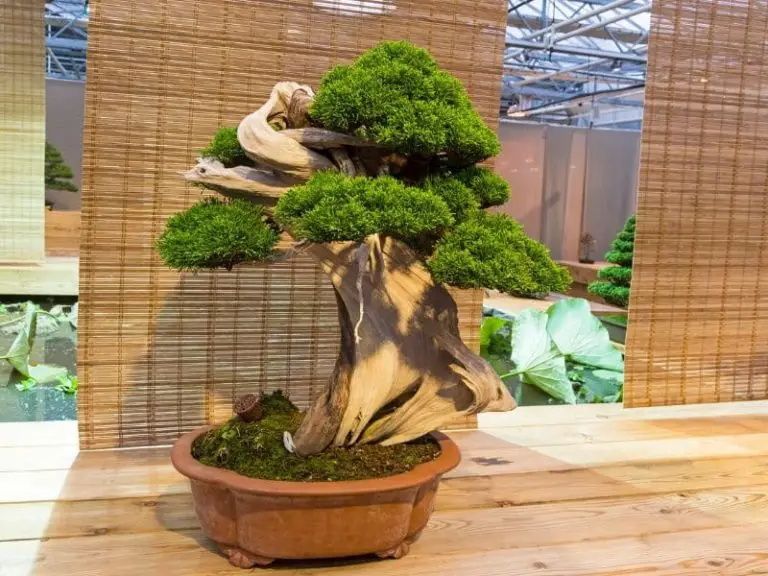Garden Juniper Bonsai | Juniperus Procumbens Nana

Juniper procumbens nana, otherwise known as the Garden Juniper bonsai tree, is a shrub that’s part of the cypress family. Native to Japan, you may recognize it from the Karate Kid movies, which is why some enthusiasts call it the “Karate Kid” bonsai. They tend to grow in rough mounds before shooting out a long stem for further growth, which is what makes it such an interesting specimen.
Here’s what you’ll find in this bonsai guide:
Here’s what you’ll find in this bonsai guide:
Quick Juniperus Procumbens Nana Care Sheet
We’re about to extensively explain how to care for the Garden Juniper bonsai tree. Here’s a quick overview of what we’ll cover if you need a quick fact sheet.
Recommended soil
Standard mix, while most are tolerant to sodium and alkaline conditions
Watering
Summer: daily; winter: when needed
Potting season
Middle to late spring, every four to five years
Shaping and pruning season
Shaping: late winter to early springPruning: late spring
Light
Full sun outside (not ideal for indoors)
Humidity
Moderate to high
Fertilizing
Once a month in summer
Propagation methods
Cuttings, seed, air and ground layering
Pests and diseases
Aphids, scales, mites
Growth patterns
Strong growers that bunch up and then produce a long shoot. Will die if all foliage is removed
Recommended styles
Any style, while small bonsais are ideal for saikei or penjing groups
Native area
Japan
Scientific Classification
- Division: Pinophyta
- Class: Pinopsida
- Order: Pinales (pine)
- Family: Cupressaceae (cypress)
- Genus: Juniperus (juniper)
- Species: Juniperus procumbens nana (garden juniper)

How to Care for a Garden Juniper Bonsai
The Garden Juniper bonsai care is easy, but you need to ensure it has the right environment to promote growth. Let’s take a look at the aspects you need to consider.
Best Soil
This bonsai will handle a standard mix of potting soil. There needs to be sufficient drainage, as this species doesn’t like its roots resting in stagnant water. It also should be sturdy enough to provide support when it grows bigger.
The Juniperus Procumbens Nana is one of the few juniper bonsais that can comfortably live near the seaside. It has a tolerance for sodium in the soil, while it’s quite comfortable with high alkaline levels.
Watering and Humidity
When the sun beats down in summer, feel free to water daily. You should ensure that the soil never dries out, while it should also not retain any moisture for too long. When winter arrives, test the soil daily until you feel that it’s dry before watering.
The Garden Juniper bonsai loves moderate to high humidity, which is why you should rather mist spray juvenile bonsais rather than watering the soil. It can also handle sea air very well, so don’t worry about placing it on your balcony near the ocean. Take care not to disturb the substrate or roots with a watering can that drops large amounts of liquid.
Repotting
Repotting is essential for all bonsais to give the roots new soil, nutrients, and space to grow. Evergreens like conifers don’t have massive root systems like deciduous trees. Therefore, you can get away with repotting every four to five years. However, you should assess the health of the roots annually to make the right call.
Once you remove the Juniperus Procumbens Nana from the soil, you should only prune back one-fourth of the lower roots. If you cut back too much, it may die. While you can generally repot any time of the year, it’s recommended to do so in middle to late spring.
Shaping and Pruning
To prevent too much stress on the Garden Juniper bonsai, it’s best not to repot and perform heavy pruning in the same season. If you’ve transplanted it, leave it alone for the next few months to settle in. It’s better to pinch back some leaves rather than cut them off completely to maintain the bonsai’s health.
The tree does well with wiring, as it bends into style easily. Try not to remove all growing tips at the same time, as the leaves will change to brown, and some of them may wilt and die. When you see dense foliage, thin them out slightly with small, sharp scissors.
Location and Sunlight
The Juniperus Procumbens Nana bonsai is not suitable for growing indoors. They prefer full sunlight for as long as possible during the day, while some shade is vital during high noon. You’ll want to keep watering on a daily basis, as it will be thirsty from the heat. Remember to also provide humidity by spraying the leaves.
In winter, you can bring it inside during the night if temperatures go below 15°C. An interesting feature is seeing the leaves turn purple when the winter sets in. You can also prepare it for winter by burying it with the pot in the ground with the soil up to the first branch. Ensure it gets rain and water, but less light.
Fertilizing
Rich fertilizer with 2:3:4 or blood meal will help to give the leaves an excellent green color. You’ll want to only feed your bonsai once a month, as it’ll grow slowly during spring and summer. You can also use liquid fertilizer, as long as you dilute it to half the recommended strength.
When winter arrives, stop providing fertilizer completely. It’ll go into dormancy, and you need to let it have its rest over the cold months. You can start it up again a few weeks before spring arrives.
Propagation Methods
You can grow juniper bonsai trees from seed, but a preferred method is via cuttings. Aim to cut a thick branch during late spring or early autumn, letting the roots grow and settle over the winter period. When spring arrives, you should see new healthy shoots.
Another two methods worth considering are air and ground layering, with the former being the more successful option. Use a black bag over the layer so that algae doesn’t form. When you see roots appear, make your cut and place the new bonsai in your prepared soil.
Pests and Diseases
The tricky part of growing a Garden Juniper bonsai is with the foliage. If it becomes too dense, it will turn into a home for insects and pests. It’s for this reason that you should thin them out when the mound becomes too large.
Common pests are juniper aphids, mites, webworms, and needle miners. Rust fungi are also a general problem that arises if you don’t take proper care of your miniature tree. Inspecting the leaves, bark, and soil should be a daily routine, even in winter.
Growth Patterns
A Juniperus Procumbens Nana should always have green foliage, or it will die. When it starts growing in spring, you can expect to see massive mounds appear. When there isn’t any more space, a longer shoot will appear for further mounding down the line.
You can shorten stems that are too long to promote new growth. It should start new mounds where you cut it, so take care of the location you choose. Always pinch off new shoots the moment you see them growing from a spot that you want to keep clear.
Recommended Styles
You can use any bonsai style that you favor for your Garden Juniper. If you’re nostalgic, you can watch the Karate Kid movies to see how Mr. Miyagi did it. Enthusiasts love cascading, formal uprights, forests, and root-over-rock, to name a few.

Considerations for Garden Juniper Bonsai Care
If you’re considering buying a Juniperus Procumbens Nana, there are some aspects you should look at first. Many new bonsai growers often don’t think of these elements, and they end up regretting their choice later.
Not an Indoor Bonsai
The Garden Juniper bonsai is not ideal for indoor growing. It needs full sunlight for most of the day, and filtered light inside your home isn’t good enough. You’ll also need to ensure that there’s enough humidity in the air, or the leaves might start dying back.
Foliage Types
Most junipers will present two types of leaves over their lifetime. Juvenile trees have needles to help them catch enough sunlight during the initial growth. As they mature, the leaves become scales. However, factors like overwatering, heavy pruning, and bending may delay this transformation.
Make Sure You Have the Right Juniper
Many people see the term ‘juniper’ as the name for all species in the genre. They don’t specify what type of juniper they have or you’re buying. Different species have slightly different requirements, and you should always make sure to identify the one you have.
Common Issues When Caring For a Juniperus Procumbens Nana Bonsai
There are some signs of danger to look out for Garden Juniper bonsai care. Besides studying the leaves and bark for pests, here are some other elements to investigate:
- Rust fungus is a permanent infestation that can’t be cured. You can treat it with fungicide or cut off the galls, but the fungus will most probably return.
- Yellow foliage may represent signs of spider mites. Place a paper under some leaves and shake the branch. If small black objects walk around, then you have these pests. You can treat your juniper with insecticidal soap.
- Tip and twig blight may cause the leaves to turn brown. This effect is usually caused by dryness or spider mites. To prevent the spread, prune the branch back to behind the brown leaves.
Exciting Facts About the Juniperus Procumbens Nana Species
We’ve collected a few interesting facts about the Garden Juniper bonsai tree. Feel free to read these at your leisure.
- Of course, the most famous fact is that many call it the Karate Kid bonsai, after appearing in the classic movies with the same name;
- Some people in Japan consider it a wild plant, as it grows wildly and fast along the ground;
- This juniper is seen as endemic to several regions in Japan, and its native origins to a specific location are often disputed;
- The ‘nana’ cultivar has received the Royal Horticultural Society’s Award of Garden Merit award in the United Kingdom;
- Juniperus procumbens nana is often confused with Juniperus chinensis, which is the Chinese cousin of the Garden Juniper.

FAQs about the Garden Juniper Bonsai Tree
Please read through these questions people always ask in case you have any queries. Feel free to contact us if you have any other questions.
No, it’s not advised. The bonsai prefers full sun for as many hours as possible. Indirect or indoor light won’t help, and its leaves may die back if it doesn’t receive direct sunlight. You’ll also need to ensure there’s enough humidity.
If you leave the juniper bonsai to grow, it should reach up to 4.5 ft wide and 12 inches tall. It has an annual growth rate of four to six inches, but it all depends on how well you look after it.
You’ll need to ensure it receives a minimum of five hours of direct sunlight. Even if it’s winter, the bonsai should remain outside to gain as much light as possible.
Junipers grow incredibly slow. If you see one that’s five feet high, it could be as old as 50 years. If you look after your Garden Juniper, it can last anywhere between 350 and 700 years. Some have even surpassed 1,000 years.
If a branch has no green growth or leaves with a color different from green, no further development will occur. You’ll have to prune it back to encourage new growth. Please note that the juniper tree must have some green foliage; otherwise, it won’t survive.
Brown leaves can be a sign of a few causes. The top ones are twig blight or spider mites, which you’ll need to take care of before it spreads. You’ll also need to prune off the bad leaves.







